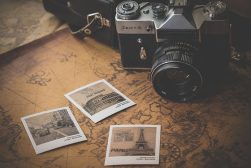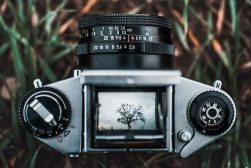
How to Find Great Places to Take Pictures Near You in 2023
Looking for awesome photography locations for your next photo session? This guide teaches you all the tips, tricks and online resources you need to know.
By Ana Mireles
Do you know how to find places to take pictures near you?
You probably see amazing pictures online and wish you had a fancy studio or the opportunity to travel to exotic places to take the same kind of photos.
But those things aren’t always necessary for a fantastic photoshoot.
What you do need is a location that suits your creative vision.
Finding the right location is important for taking unique photos.
It doesn’t matter if it’s a downtown area with old buildings or a hiking trail with spectacular views.
You’ll need to find amazing places that match the vibe you’re looking for, and this isn’t always easy.
You might need fall foliage when it’s off-season or tall buildings when you’re in a small town.
The right spot also needs to fit the technical requirements and logistics for the project.
So, a great backdrop is not always enough to host a shoot.
In this article, you’ll find eight different ways to look for locations online and offline – a must-have resource for every photographer.
So, keep on reading!
8 Ways to Find Places to Take Pictures Near Me
Use a dedicated website
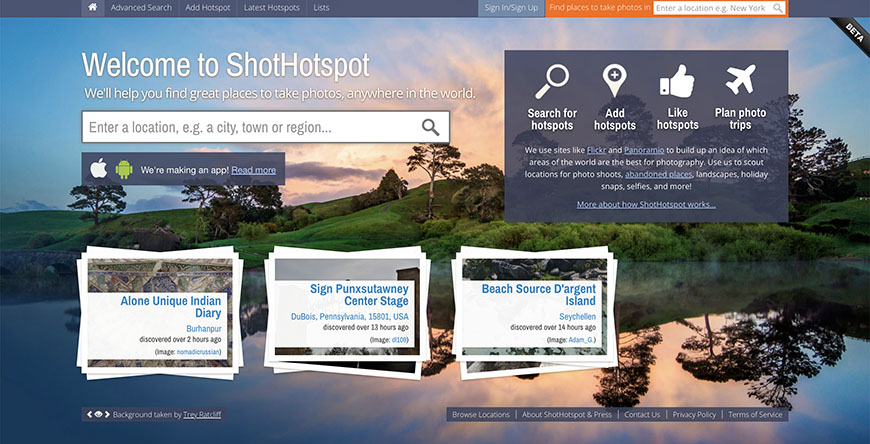
There’s a continuously growing number of people interested in photography, and every one of them needs to find the perfect backdrop for their photos. This is as true for taking family photos as it is for a professional photo shoot.
As a result, some visionary developers and photographers decided to build websites and search engines to help us find good places to take pictures.
ShotHotspot
ShotHotspot.com is a search engine specifically designed to look for photoshoot locations.
It analyses the location data of images published on photo-sharing websites like Flickr. It also allows users to add photo hotspots manually.
Searching for a specific city gives you the results of the best spots in it and the surrounding area. You’ll also see ratings based on the likes and comments the hotspot and its photos receive.
Anyone with an account can enrich the results by adding information or uploading photos of an existing hotspot. They can also add more spots.
Another feature is that you can create a list of hotspots. This allows you to visit the best locations on a trip or organize a photo tour.
If you prefer not to create an account, you can still use the website to find the perfect spot. Simply type in the city in the search bar.
You can refine the results by using the Advanced Search. Here, you can expand or narrow the area to get more accurate results.
You can also combine the location with a keyword, for example, New York and Covered Bridge.
Then, you can choose up to three categories from the ones available to refine the search. For example, Landscape + Water/Coastal + Sunset/Sunrise or People/Portraits + Urban + Architecture.
Finally, you can browse the Hotspot lists. All these features make it one of the most popular websites for finding the perfect places for your photo shoots.
Locationscout
Locationscout.net is another search engine for finding places to take pictures. Based on my experience, there are fewer locations than the ones you can find in ShotHotspot. However, this may be different depending on the place you’re looking for. It may also change with time, depending on how much each website grows.
In any case, while some locations may show up in both searches – others won’t. So, it’s always a good idea to combine the results to maximise your search.
You can search for a specific city and get an overview, the number of spots, and sample images. Unlike ShotHotspot, you can do a country search, so it’s easier to find locations in larger areas. However, you can’t access the map unless you’re registered.
The registration and map access are free – but there’s also a premium account. This gives you access to more features, like an add free version and the learning section.
Explorest
Unlike the previous two sites, Explorest.com doesn’t have a search bar. You can browse the available countries or cities via a drop-down menu or a map.
You can see the number of photo locations available in each city on the menu. If you prefer to use the map, you’ll see color-coded pins on top of the cities with the number of locations in them.
The list is limited because this website focuses on quality over quantity. It doesn’t use the geotag of every photo out there. Instead, the results are curated by and for photographers.
When you click on a location, you can see a sample photo taken there. It also gives you some important information to plan your trip.
For example, it tells you whether it’s publicly accessible or not. It shows the opening hours, the parking situation, and even the photography skill level.
If you have a pro account, you’ll get access to the photo’s metadata and some tips like the best time to go.
The website also has a blog featuring articles about photo shoot locations and ideas for photo sessions.
Pixeo
Pixeo.com holds a curated selection of great places around the world to do photo shoots. The collection is constantly growing thanks to contributing users uploading their work.
However, each upload needs to be approved by Pixeo. This allows them to maintain the quality of the information they provide and the photos they showcase.
The photos and locations available on the website are only the best. You can use the mobile version if you want to see all of them.
You’ll find a search bar on the homepage where you can type in a country or city. You can also browse the Photo Spots to explore a region or use the Photo Maps.
The Photo Maps are divided by region, such as “Europe Photo Map” or “Canada Photo Map.” They can also be themed. So far, there’s only one of these – “Abandoned Photo Spots Map” – but I hope they introduce more in the future.
You can also find Photo Guides. Some of them are broad and introductory, while others are more specific, featuring a city or a landmark.
Lastly, they host Photo Challenges. You can win the chance to be featured on their website and social media, or prizes like Amazon gift cards.
Scouty (UK only)
This website is dedicated to finding a location for photo or film projects. The search engine allows you to combine a keyword with a city or area.
The keywords can be about the type of project, such as “fashion” or “music video.” But they can also be about the style, for example, “modern” or “vintage.”
This feature makes your search much more efficient. On top of the usual photo studios or houses, you can find locations as unique as a race track, church, or even an airport.
It has a built-in booking and payment system.
Peerspace
Peerspace is a fantastic location search engine. You can find spaces to do a photo shoot, host a workshop, throw a party, etc.
It has many filters that help you to get the best results. You can start by typing the type of project, the city, and the date and time of your photo shoot. You can leave it blank if you’re flexible about any of these.
Once you have the first results, you can filter the list by price, attendees, and keywords. You can enable more filters from the provided choices to refine the results even more.
For example, in the Amenities section, you can ask for an elevator or a fire pit. You can also exclude locations without Instant Booking or the ones that don’t provide any extra security and health measures.
Film location websites
The technical requirements for a film or video are much more complex than those of a photoshoot. That’s why there are websites dedicated especially to this type of production.
While they’re very useful, they might be in a different price range from what’s available to the average photographer.
That’s why I won’t go into too much detail here. However, I thought it could be helpful to name some of the most popular in case you want to check them out.
- Giggster
- LocationsHub
- Set Scouter
Browse online
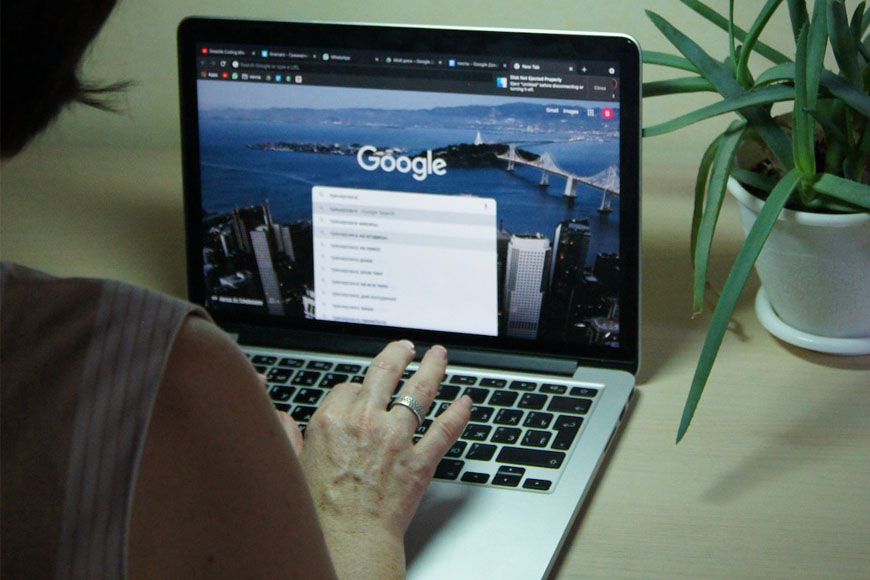
Credit: Valeri Mak
Dedicated websites like those above can save you a lot of time when looking for great locations for your photo sessions.
The downside is that they can be centered on certain countries or cities. You’ll need different sources if you’re looking for a place that isn’t showing up on those websites.
So, how is it that you find anything in today’s world? By googling it.
Search engines are an excellent place to start searching for places to take pictures. You can begin with something vague such as “best photo spots near me” or “best photo spots near X town.”
You’ll surely find blogs, forums, or Facebook pages that cover this subject. Don’t stop at the main article or post; browse through the comments too. You’ll find lots of suggestions there.
If you have something more specific in mind, then Google can go either way. Usually, you’ll get more relevant results because your question is more explicit.
However, if it’s something unique, it might be that nobody has shared anything similar. In that case, you’ll need to broaden the search.
For example, if you want to photograph your model under a stone arch bridge, you can google a stone arch bridge in your city. You can search for “arch bridges” or simply “bridges” if nothing shows up.
You can follow some of these tips to get better results from your Google searches.
Use quotation marks
Using quotation marks to isolate a phrase will show results significantly more relevant to your search. For example, I just typed “best locations for family photos” into Google (without quotation marks) and got 4,660,000,000 results.
Many of them will talk about the best location for a family vacation or tips to take the best family photos. This is because Google searches for those words individually.
Instead, typing “best locations for family photos” with quotation marks only got 7,540 results. Those are the results that include the entire phrase. Therefore, it’s more likely that the content is closer to what I’m looking for.
Use the plus sign to include keywords
You can join keywords or phrases using a plus sign to refine the results. So, you can search for “best places for an engagement session” + “fun spot” + Sydney.
Then you’ll get the best places in Sydney that are fun to do a photo session. This will be more useful than a list of random places to do engagement sessions.
Use a hyphen to exclude results
If there’s anything specific that doesn’t interest you, it’s easy to remove it from the search. For example, “bridge in Amsterdam -covered”.
This will show you all the websites that talk about a bridge in Amsterdam but exclude the ones that talk about a covered bridge.
Use apps

Some of the previously mentioned websites have a mobile version – and often the mobile apps have a different set of features.
As such, I’ll include them in the list even if the browser version has already been mentioned above.
Streetography
This app uses geolocation data from 500px images to create a map. You’ll see the pictures as pins on top of every popular spot.
It also allows users to upload their own content. The app is free to use, but it’s only available for iOS.
The popular photo-sharing app allows users to geotag their posts. You can use this information to find exciting places to take pictures around your area.
You can also search by hashtag. This is useful because many users prefer to use the city’s hashtag instead of geolocation because this allows them to post after they’ve already left the spot.
Pixeo
The app is free, but there is a Pro version. As a Pro user, you’ll have the benefit of using the app ad-free. You’ll also unblock features like “finding places to take pictures near me” and “saving your favorites.”
Another perk is that your photos get geotagged automatically. This is when you shoot and upload them directly from your phone.
Lastly, many spots appear only on the app. This can be a good or a bad thing – that’s up to you to decide.
The app is full of great places, but there might be some that aren’t as relevant. You’ll find fewer choices on the website, but they represent the best of each place.
The app is available for iOS and Android phones.
Explorest
On top of the information provided on the website for each location, you’ll also get real-time weather by using the app.
Users can also take a picture and make in-app notes while they’re at the location. The app is available for iOS and Android.
Locationscout
If you have a premium account with Locationscout, you’ll get the Around Me and the Direct Navigation features. These help you look for spots while on the road.
The app is available for iOS and Android.
ShotHotspot
At the time of writing, the app is still under development. You can go to the website and subscribe to get a notification as soon as they release it.
You can also send in your ideas or get involved in the development (just keep in mind that this voluntary/unpaid).
Explore your city and talk to the locals

Credit: Oziel Gomez
The world is full of hidden gems. Not every corner has been photographed and geotagged and published online.
The best way to find a great spot is by exploring the area. The favorite spots from other photographers are a great place to start.
At some point, though, it’s better to find your own locations. This will help you to get truly unique photos.
You can scout the area with a specific location in mind when you’re working on a project. Even better, you can keep your scouting mode on all the time.
You just need to keep your eyes open. Whenever you find a great spot, make a note and take pictures. Remember to enable the geotagging feature on your camera.
There’s nothing like experiencing a site yourself. If you’re trying to find a place with natural beauty or historic charm, you’ll get a better feel in person.
Unfortunately, this isn’t always possible. In that case, you can use Street View on Google maps to “walk” around a street and find the best spots.
This is a great way to see the style of the buildings, shops, signs that could work as backdrops, etc.
It’s also great to get a sense of distance.
Ask your colleagues
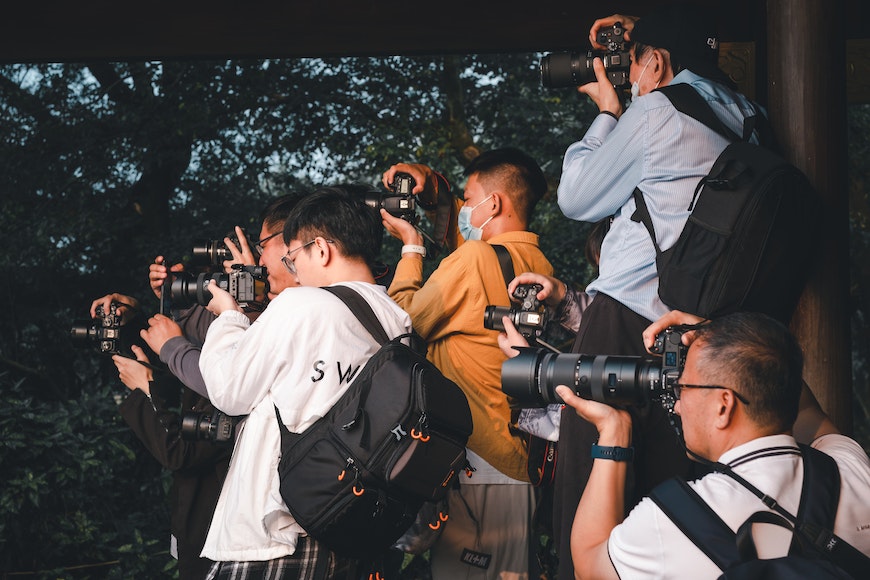
Credit: The Whale
All photographers have their go-to locations for their photo shoots. Reaching out to them and building a network is an excellent way to exchange advice.
Your direct competitors might feel reluctant to share their secrets. For example, wedding photographers may not want to tell you their favorite spots for an engagement session.
Instead, try contacting colleagues who specialize in family portraits. Also, try talking with landscape photographers. In the end, you need an excellent backdrop for your portrait. So, the location advice is not about the portrait itself.
A landscape photographer can tell you where to find a pond, a beautiful park, or an area with good natural light.
Another good resource is amateur photographers. Since they’re not competing to get clients, they’re usually more open to sharing good findings.
They’re also easier to contact just for chit-chat. Look for their communities online – there are usually forums or Facebook pages.
They may organize photo walks or meet-ups once in a while, and that’s a great place to talk and exchange advice.
Of course, it’s only fair that when you ask them to share their favorite locations, you share yours in return.
Follow the light

Another way to find the location for your photo sessions is to follow the light. For example, if you love shooting silhouettes, you need the sun behind your subject. So, it needs to be quite close to the horizon.
Or let’s say that you’re hired to take some family photos, and your client can’t be flexible about the time.
You’ll need to find a location where there’s good light when you’re taking pictures. You may want to find a place where the sun hits directly because you need more light.
Or maybe you need a building casting a shadow to avoid direct sunlight. Whichever look you’re going for, it’s all about the light.
In this case, you can choose the location based on the sun’s position and weather conditions. There’s an entirely different set of apps and websites just for this.
You can use Google Earth (not Google Maps) and The Photographer’s Ephemeris. These two applications can help you to track the sun’s trajectory on any given day.
- Read more: How do you use The Photographer’s Ephemeris?
You can then see how the light will be hitting on a specific location on the day and time you schedule your photo sessions.
Unfortunately, The Photographer’s Ephemeris app is not available for Android. You can always use the browser version – it’s more limited, but that’s not to say it’s not helpful.
Google Earth has the problem that it’s been banned in some countries. It also obscures certain areas due to security issues. However, if it’s available in your country, it’s a handy tool for finding the perfect location to take pictures.
Also, use Accuweather or a similar app to track the weather by the hour using your location. It might be cloudy on one side of town and sunny on the other.
Hire a location scout

Credit: Cottonbro Studio
This option isn’t suitable for every project. Hiring a location scout can cost around $500 to $800 per day, so this is only a possibility for high-end photo sessions.
That said, it’s also a helpful option if you need to find a location abroad as they can help you arrange the logistics.
A location scout is a professional figure typically present in film productions. However, they may also be necessary for video making or photo shoots.
They’re provided with a list of requirements based on the needs of the director or photographer. Based on this, they visit potential locations. They photograph them and collect valuable information for the logistics.
For example, they research accessibility. They check if there are toilets available, if there are enough power outlets, etc.
They may also provide information on how the light is at a particular time of the day. For a complete report, they take pictures covering all angles.
With all this information and the accompanying images, the photographer can make a shortlist of the best places for their photo shoots. They can then scout only the best ones in person without wasting time visiting all of them.
A scout can also help you contact the property owners. When necessary, they can collect the permissions required for the project. (Although, in big productions, this may be the responsibility of the location manager.)
- Read more: How do you do location scouting?
Flip through different magazines
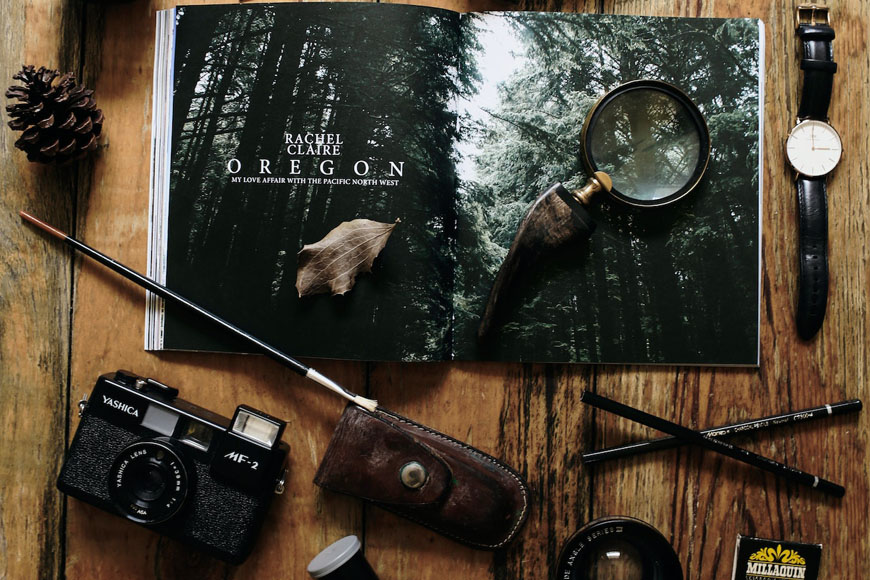
Credit: Rachel Claire
When looking for the perfect location, sometimes you need to think outside the box.
Instead of looking for locations for photo shoots, think about what other things are interesting in those locations.
Let’s say you want to do an autumn family photoshoot. You can look in travel magazines for routes and destinations known for their fall foliage.
Another example is to look at sports magazines for hiking trails to find unique places for your nature photography.
- Read more: What are the best photography magazines?
Browse through real estate listings

Credit: Cottonbro Studio
When talking about locations, many people think of outdoor photo shoots. You think about finding a green space in a park location, a covered bridge downtown, or a street full of graffiti.
This isn’t always what you need. You might need a house with a big master bedroom for a boudoir session. Or you may need a country-style kitchen for a lifestyle photo shoot.
If this is the case, you can check real estate listings, vacation homes websites, and even hotels.
Keep in mind that all these will be private properties. As such, you’ll need the owner’s permission to shoot and publish those images.
So, be open about it from the first contact to avoid wasting their time and yours. Also, once you agree on the price and terms, be sure they sign a location release form.
Final Words
The world is full of places where you can take great photos year-round.
Sometimes the best location is just a short walk away. Other times, you need to drive into the middle of nowhere to find the best spot.
Wherever this place is, you need to have the right tools in order to find it. Hopefully, you found enough ideas in this article to search for your next photography location.
I find that exploring the area is the most enjoyable way of looking for a location. However, I understand that it may be limiting. That’s when you need to take advantage of technology. And most importantly, use the experience of other photographers.
Remember to keep a list of all the best photo spots and great backdrops you find. You might not use them for this project, but you never know when you’re going to need them.
How do you find your locations? Share your tips in the comments below.


Check out these 8 essential tools to help you succeed as a professional photographer.
Includes limited-time discounts.





